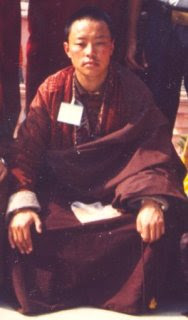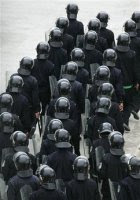Agam's Gecko


Friday, May 02, 2008
REPORTS ON AMDO POLICE SHOOTOUT DIFFER FROM CCP VERSION; PRISONERS DIE
| T |
he story now emerging from the shootout reported this week in Darlag County, Golog Amdo (Ch: Qinghai) differs significantly from the official version published by state-controlled media.
The Times has learned that the ethnic Tibetan police officer was killed by outraged locals after he first opened fire on a young monk, Choetop (TCHRD spelling). The monk was wanted by the authorities after he had pulled down the Chinese flag from a building on March 21, and burned it. The officer came to the village on Monday to arrest him, and then shot him. It's not known if the monk resisted arrest.
After the monk was killed, angry villagers in Shanghongke turned on the police officer, the sources said. They fetched guns, commonly used in the area for hunting and also in provincial border disputes among Tibetans vying to collect caterpillar fungus for traditional herbal medicines, and shot the police officer. State media said that Lama Cedain, who was also ethnic Tibetan, was shot six times.The state-run media version of this portrays the officer trying to arrest Choetop, being killed first, and his comrades then killed Choetop.
The young monk’s father, identified as Sangsang Lailai, was arrested in the police raid, the Tibetan sources said. It was not clear if anyone else was wounded in the gunbattle or how many other people may have been detained.
The description given by the Chinese media of the dead Tibetan man, as an "insurgent leader" didn't really fit with the only picture we have of Choetop. I'm still not sure when it was taken, but he was 22 when he died. It looks like he's under arrest there, with the label pinned to him. And notice the truncheon behind his left shoulder. All those young people who pulled down flags at their schools over the past 7 weeks must also be considered by the authorities to be "insurgent leaders."
On 28th March, around 83 corpses were burnt altogether in an electrical crematorium, which was built by the Chinese government a few years back in the Dhongkar Yabdha shang town in Toelung Dechen county under Lhasa Municipality.One Drepung monk who was arrested April 12 has died in prison, with no further details available. Two women reportedly died immediately after their release from a Lhasa prison. Earlier reports have indicated that when others have been tortured so badly they were near death, they would be released to avoid official responsibility for their deaths.
Moreover, some eyewitness accounts confirmed that at around 10.30 pm (Lhasa local time) on March 17, dead bodies of several were seen in two army trucks near a petrol pump located towards the west of Lhasa [this petrol pump has been one of the most restricted sites since the protests began in Tibet]
Due to a heavy traffic jam around this petrol pump, a few Tibetans reported having seen blood discharges from the two trucks that were carrying dead bodies. In addition to this, there are more reports of dead bodies being transported to Toelung Dechen County in army trucks.
On the evening of March 15, an eyewitness source confirmed seeing dead bodies being carried in a truck towards Toelung County.
CTA has released the names of a Lhasa tailor who died from his gunshot wounds, and two monks who were brothers and who both died around March 14, bringing the total of identified fatalities of the crackdown to 64.
Another of those killed by gunfire on March 14 was Lhakpa Tsering, who was a tourist vehicle driver in Lhasa. His case was previously cited here from an earlier CTA report, and from a translated Tibetan language call-in program offered by RFA Unplugged here. A Tibetan lady who personally knew Lhakpa Tsering and his 2 year-old daughter, described how his body was confiscated before his funeral could take place. Security forces took it away from the family, claiming they needed to investigate it. They cremated it at Toelung (west of Lhasa) and returned a bag of ashes with his name on it to the family.
Following the Lhasa riot on March 14, protests broke out the next day in adjacent areas including Phenpo Lhundup County to the east. In the violent suppression which resulted, many were reportedly killed and many more arrests were made. One of those detained was a 31 year-old farmer named Dawa, from Dedrong village in this county.
Multiple sources say that during two weeks of detention in prison, he was subjected to torture by the Chinese prison guards. When it became evident that his health was failing, the Chinese prison authorities quickly released him on 27 March 2008 for medical treatment. At the time of the release, his health was already in a very critical condition. After spending four days in hospital, he died on 1April 2008.One of the more immediate casualties of the suppression in Phenpo County is now identified as Junpa, a 23 year-old farmer, who died of Chinese bullet wounds on March 15. It is not known how many Tibetans died in this incident.
Adding insult to the injury, the Chinese authorities charged the deceased's family with a fine of 1000 yuan (US $ 125) for causing destruction to public property and bringing damages to economy.
Phenpo County is now undergoing a major "patriotic" re-education drive in every sector of society. As in all the other areas where this policy is taking hold, this is unlikely to result in the lessening of people's anger toward the authorities.
.











 Our way of saying "thanks" in the Thai way. Here a nak muay Thai (kickboxer) offers respect and thanks for his teacher (wai khru) before a match. This is our local variation on the ubiquitous "hat tip" used in general blog culture.
Our way of saying "thanks" in the Thai way. Here a nak muay Thai (kickboxer) offers respect and thanks for his teacher (wai khru) before a match. This is our local variation on the ubiquitous "hat tip" used in general blog culture.






